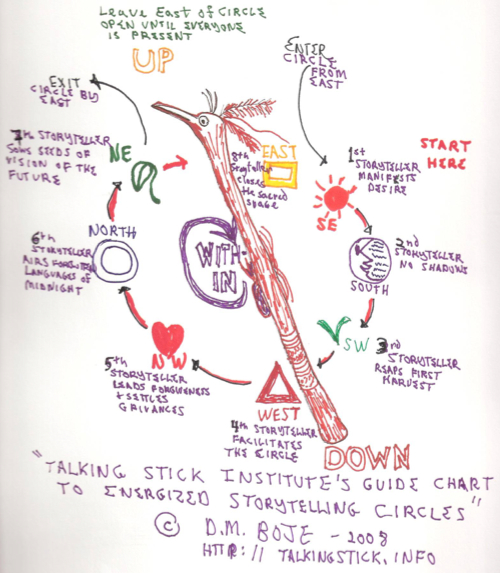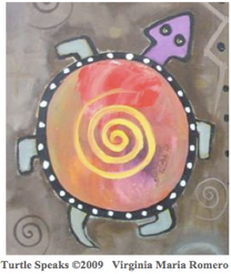TalkingStick.Info
 A Talking Stick is an ancient way of taking turns, building community, allowing people to do Story-Listening, not just Story-Telling. It is possible to enter a manner of storytelling and facilitation that harkens back to premodern methodology using Talking Stick Story Circles.
A Talking Stick is an ancient way of taking turns, building community, allowing people to do Story-Listening, not just Story-Telling. It is possible to enter a manner of storytelling and facilitation that harkens back to premodern methodology using Talking Stick Story Circles.
August 27 2014: David Boje (Management Department) facilitated a Teaching Academy session, ‘Teaching with Storytelling’ August 27 2014. Participants learned ways to use several storytelling tools to help students tell stories. The tools included picking an object to represent their character in a story, using the Talking Stick to enable turn-taking and story-listening skills, and ’Sand Play’ setting out characters in a sand tray, for example, to tell their life story of becoming a teach up to where they are today. After the session, there was a book signing at Barnes and Noble. The book is called Storytelling Organizational Practices - Available from Routledge 2014; See Reviews; See Book Signing Flyer For the film and notes of ’Teaching with Storytelling’ see http://talkingstick.info
Talking Stick Story Circles:
Talking Stick Story Circles are conversational encounters with a back-and-forth of story-telling and story-listening, noticing fragments of retrospective narrative and fashioning as well prospective antenarratives (bets of story transformative possibilities; before Grand Narrative) that affect the Being, that change Flat Grand Narratives into something vibrant with future potentiality. More see PDF Talking Stick Story Circles Guide
What is storytelling?
Tribal Wisdom and Storytelling: Drs. David Boje and Gregory Cajete
Storytelling is the interplay of Grand Narratives of a culture or society with the Living Story Webs of individual experience. The aggregate relationship between Grand Narratives (GN) and Living Story Webs (LSW) is a pattern-connection of what I call Antenarratives (see Wiki on Antenarratives or go to http://antenarrative.com/.
LSWs come from work we have done trying to understand what is different about Native American LSW (Tribal Wisdom) practices and those of Western Narrative (i.e. GN). GN completes the gesture of Universalization while LSW is a gesture of Particularization, and Antenarratives make the dynamic connection between them.
One way to develop LSW is to through an Embodied Restorying Process. This is a way to recharacterize the Character we are taught or socialized to be in GN. By externalizing and sympathiziing with the benefits, and understanding and Revising the consequences, we can recover Little Wow Moments of exception to GN gestures. These Little Wow Moments become the basis of Embodied Restorying. The final step is important, to build a support system for the new story, in a family system or for organizaitons, ina support team. This can be done by letter writing.
Embodied Restorying Guidelines
Table 1: 7 STEPS of Embodied-Restorying Process (ERP) - Adapted from Boje, in press; Rosile & Boje, 2002 |
1. Recharacterize (authentic Self identity) Story that is ideal – when you were at your best |
2. Externalize (re-label) Make the character in old story the Problem, not the person |
3. Sympathize (benefits) – of old story |
4. Revise (consequences) – of old story |
5. Strategize (Little Wow Moments of exception to grand old story) |
6. Restory (rehistoricizes the Grand old Story by collecting Little Wow moments into New story) |
7. Publicize (support networking) e.g. letter writing with supporters of New Story |
Example of how this is used with Veterans and their families in post-deployment - Sun News, August 2014 We have been using Sand Play in our work with formerly homeless veterans. Sand Play is a way to realte the Symbolic to the Imaginary and the Real.
A good place to begin is with some Guidelines for using a Talking Stick
Talking Stick Circle Guidelines (David Boje & Joe Gladstone, 2008)
1. We sit in circles, not pyramids.
2. The person with the Talking Stick is the designated story-talker.
3. Pass the Talking Stick clockwise. Start with the person sitting in the East-most position, then go to the right. In Talking Stick going clockwise is an earth-process. Otherwise the magic is undone.
4. Persons without the Talking Stick, please listen, write notes, and notice the story. Focus your listener attention on the storyteller with the Talking Stick. Let your mind recall stories as the teller tells stories.
5. Try to limit interruptions. A person with the Talking Stick can pass it to someone for a clarification, question, or amplification on a point, then call the stick back to finish their story.
6. There will be multiple rounds of Talking Stick Story Circles. Each time there is a question. At the end of a round of story-sharing, story-noticing (story-listening), a spokes-person repeats the main themes, issues, resolutions, and proposals that came up. So be sure to take notes.
7. The output of Talking Stick Circle is ideas, proposals, and stories of a vitalized community. Designate people to listen, to observe, and to provide a report out of the collective story that is emerging in the Circle.
8. The point is to create a collective story, one that is faithful to everyone's living stories, to unify in community.
More see PDF Talking Stick Story Circles Guide
Facilitator's Role
If someone interrupts, and speaks out of turn, or side conversations start, or not everyone is listening to the storyteller holding the Talking Stick
The facilitator sitting in the West has the head-person position. It is their job to orient the storytellers in the Talking Stick guidelines, and to intervene (politely and diplomatically) when the guidelines are being broken. More see PDF Talking Stick Story Circles Guide
Talking Stick Circle - Ancient Ways of Being
Figure 1 - The Place for the Facilitator in the Directions of a Story Circle (Drawing by D. M. Boje).
Different tribes assign different meaning to the cardinal directions. The Facilitator usually sits in the West, and people enter the Story Circle from the East. The Facilitator brings people who interrupt back to the Guidelines.
Quantum Storytelling Conference
For the last three years a small group of storytelling scholars including ethicists, rhetoricians, management theorists, consultants, and students has gathered in Las Cruces New Mexico to explore new ideas. We are intrigued by the complexity of human social systems, poly-vocal dialogue, the post-Newtonian worldview, and quantum physics. Led by Dr. David Boje, the group is growing rapidly and is not afraid to consider new ideas. Please join us





